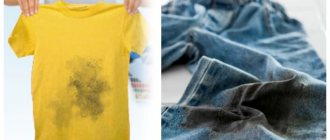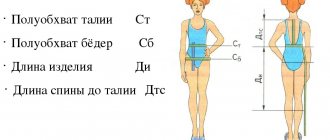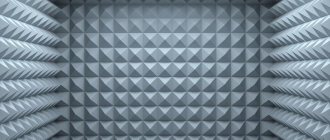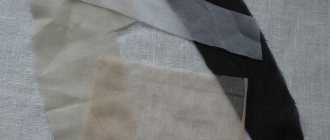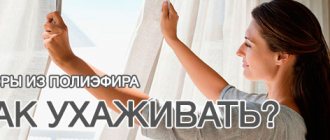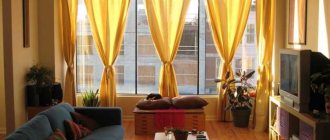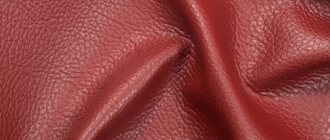When choosing fabric for a skirt, you need to take into account your body type, season, style, purpose and a number of other parameters.
The composition and structure play an important role; it is the properties of the textile that determine how durable and comfortable the clothing will be. In this instruction you will learn how to sew a year, flared, pencil, trapezoidal, fluffy and other skirts. A review with tips will help you navigate the diversity. And the calculation formula will tell you how many meters of material to buy for a particular model.
- Main characteristics of skirt fabrics
- Popular types of fabrics for sewing skirts
- Features of choice based on style
- What is better for a circle skirt and a half-circle skirt
- The best fabric for the year
- What to make a pencil skirt from
- Options for a pleated skirt
- Materials for a full skirt
- What to buy for an A-line skirt
- What is suitable for a floor-length skirt
- Seasonal selection
- How to calculate material consumption
Main characteristics of skirt fabrics
The composition of the material is important. The quality of the textile fabric depends on the properties of the fibers. First of all, you should pay attention to the hygienic properties: hygroscopicity, breathability. Properties such as strength, wear resistance, and creaseability play an important role.
The skirt material must have good hygienic properties, at the same time be highly resistant to abrasion and practically not wrinkle . All these requirements are met by mixed fabrics consisting of fibers of different origins.
Natural fibers (linen, cotton, wool, silk) are characterized by good hygienic properties, which is important for light clothing. In turn, synthetic and artificial fibers (viscose, lavsan, polyester, spandex) provide elasticity and strength.
Fabric for a summer skirt
Summer skirts have more expanse than all others. For the summer, you can take both budget polyester and more expensive cotton, linen, etc. Here it is important to determine how important such fabric properties are, such as wear resistance, shrinkage, and shape.
Of course, any natural fabrics (cotton, linen, silk) are always better, because... the body breathes, does not sweat, does not exhibit allergic reactions, etc. However, they have one significant drawback - they wrinkle and shrink after washing. For summer, from successful and more or less universal options, you can choose cambric or viscose. They are not so prone to wrinkles, but are very comfortable. In extreme heat they can slightly cool the body.
Easy option
In summer fabrics, as in any other case, it is necessary to take into account the style of the product. For straight and pencil skirts, linen, denim, cotton or silk are suitable. For the recently fashionable pleated skirts, it is better to take flowing fabrics - chiffon or silk. For most models, wet silk, cotton and viscose are suitable.
For summer, light translucent fabrics are often used, but products made from them are usually multi-layered (for example, this form of skirt may be called a “tutu”). Sometimes they even take lace or knitted fabric and add a lining underneath.
Almost any skirt fabric is suitable for sewing summer items. The most important thing is to consider what the end result should look like.
Popular types of fabrics for sewing skirts
It is impossible to list all the materials used for sewing. The most popular types of fabrics for skirts include:
- Gabardine . Ribbed suit fabric. As a rule, a mixed composition, for example, wool and synthetic fibers. It is easy to care for, holds its shape well, and practically does not wrinkle.
- Tweed . Soft wool with little lint. It has a textured surface, does not wrinkle, and has high heat-protective properties.
- Linen . For sewing skirts, fabrics with a mixed composition are most often used: linen with the addition of artificial and synthetic fibers. These wrinkle less than natural ones.
- Poplin . Thick cotton material with a smooth surface. Pleasant to the touch, holds wrinkles well, and practically does not wrinkle. It is better to use types of mixed composition, for example, cotton with a small addition of elastane.
- Chiffon . Transparent with a matte sheen. Draps well and is easy to fold. Natural chiffon has a high cost, but is softer and more pleasant to the touch than mixed fabric. Requires delicate handling and is difficult to care for.
- Velvet . Soft, fairly dense fabric with thick pile. Cotton-based velvet is coarser and denser than silk-based velvet. Thin silk threads give the fabric plasticity and softness. Velvet is tricky to care for and sew.
- Atlas . Smooth with a shiny surface. Satin with a dense structure is used for sewing straight and flared skirts. Lightweight with a high content of silk threads, suitable for models with a flying silhouette.
- Taffeta . Thick silk with a noble shine. It is characterized by high strength and low drapability, while retaining its shape well and being easily folded.
- Denim . Dense, slightly rough, characterized by high strength. Classic denim has a 100% natural composition (cotton), but for sewing skirts it is better to use denim with the addition of elastane.
- Eco leather . Dense material with a leather-like surface. A woven fabric made of cotton or polyester is used as a base. In appearance it resembles genuine leather. It is flexible and allows air to pass through well.
- Jersey . Knitted fabric is soft and elastic. It stretches perfectly, drapes well, but does not hold wrinkles.
- Coupon fabrics . Silk and cotton fabrics with repeating patterns, such as graphic and floral patterns. Most often, the main pattern is located along the edge, and small elements are located across the entire surface of the canvas. It is best to sew products of a simple cut, without finishing details.
- Pleated . The pleated effect is created due to special processing of the material. Most often these are silk, chiffon, cotton types with a relief surface, that is, in a fine fold.
What fabric are skirts made from?
Absolutely all fabrics are held in high esteem - both natural and with an admixture of synthetics and completely synthetic ones. The most popular fabrics from which skirts are made:
- Natural cotton. This material is almost universal. Thin fabrics are ideal for summer, and thick ones for the cold season. Cotton products breathe well and do not cause discomfort to wear.
- Linen. A material that has long been considered noble. Its ability to allow air to pass through gives the body maximum comfort.
Linen skirt
- Velvet. It is most often used to make holiday clothing because of its specific appearance, but recently stylists have been skillfully incorporating it into everyday looks.
- Jeans. Due to its structure, it successfully emphasizes the figure and hides imperfections. It is because of this that girls with curvaceous figures prefer him. Denim is a universal fabric for both summer and winter.
- Silk. This material is found equally both natural and artificial. Skirts made from it look very festive, and the choice of colors is almost limitless.
Silk option
- Wool (cashmere, tweed, boucle, etc.). Material for cold weather, looks very advantageous. Wool fabric can be of different densities.
- Velveteen. The material, which came into fashion not so long ago, is more suitable for the cold season. It has a specific structure, due to which it looks interesting on any figure.
- Atlas. Smooth fabric that shimmers very effectively. It is very often used on skirts for wedding and evening dresses.
You might be interested in How to make fabric waterproof using water-repellent impregnation
Satin product
As for the color palette, skirts in indigo, emerald, red, burgundy and, of course, classic black will look win-win.
Features of choice based on style
Properly selected clothes help highlight your strengths and hide your figure’s flaws. For skirts with a straight and tight silhouette, fairly dense fabrics that can hold their shape are suitable. Soft, well-draped ones are best used for sewing flared models with frills and ruffles.
What is better for a circle skirt and a half-circle skirt
Flares are easy to sew and cut: a circle or semicircle with a hole in the middle. A flared skirt allows you to hide both excess and insufficient volume in the hip area. It looks beautiful on women with any type of figure, the only nuance is the material of manufacture.
The secret is that the fabric for a half-sun or full flared skirt should fall freely , forming soft folds. Therefore, you should not choose dense materials that hold their shape but do not drape well.
To sew a summer flared skirt, it is better to use light, well-draped fabrics: chiffon, silk, cambric. You can sew multilayer models from transparent materials; they will not weigh down the silhouette.
Another option to avoid possible see-through is lining. Business-style skirts are made from thin suiting fabrics: gabardine, crepe. For miniskirts with a flared silhouette, you can use stretch denim or eco-leather.
The best fabric for the year
Godet has a characteristic feature - a tight fit in the hips with a smooth flare from the knee line. A year skirt consists of wedges of the same shape or different configurations. The model is suitable for women with any type of figure. Vertical lines visually elongate the silhouette, and the flared hem balances the curvy hips.
For sewing a classic year, thin suiting materials with the addition of wool are suitable. A spiral godet skirt is made from soft flowing types: chiffon, silk, thin satin.
Godet with graduation (the bottom line lengthens from the front to the back panel) is better to sew from fairly dense fabrics: velvet, taffeta. It is possible to use materials of different textures: a combination of wedges made of dense fabric with chiffon or openwork inserts.
What to make a pencil skirt from
A straight silhouette skirt is the basis of a basic wardrobe. For sewing a classic model, medium-weight suit fabrics are suitable. An important condition: the material must keep its shape and not wrinkle too much. It is better to give preference to mixed species.
The composition can be anything:
- wool and elastane;
- wool, lavsan and elastane;
- wool, viscose and elastane.
For summer models, the following options are quite appropriate: linen, thick cotton, knitted fabric, denim. You can also follow the tips for choosing material for a summer dress.
For the cold season, dense materials with high heat-protective properties are suitable: tweed, lightweight drape, corduroy. For a better fit of the skirt, it is recommended to add a lining to it .
Options for a pleated skirt
Pleated styles look feminine and are suitable for all occasions. When it comes to ironed folds, the fabric should be dense, but not stiff. Natural materials do not hold their shape well enough, so it is better to give preference to types with the addition of synthetic fibers. For example, gabardine, tartan, poplin.
For light styles with soft folds, materials that drape well : staple, cambric, silk, crepe-satin. Pleated fabric deserves special attention - a textile fabric with firmly fixed small folds.
Sewing from pleated fabric is quite simple; you just need to cut out the parts and stitch them on a machine. The following materials are not suitable for sewing a pleated skirt: thick knitwear, lace, drape.
Materials for a full skirt
Skirts gathered at the waist look impressive and allow you to hide excess volume in the hips. The best fabrics are those that are easy to fold, but not loose in structure. Often tulle . In this case, pomp is achieved by layering several tiers of rigid mesh material.
No less elegant, but more comfortable to wear, are skirts made of noble materials with a shiny surface: thick satin, taffeta, jacquard. To add more pomp, it is recommended to use a petticoat made of tulle or organza.
What to buy for an A-line skirt
To sew a skirt that is slightly flared at the bottom, it is recommended to choose dense fabrics that hold their shape well. The material should not be loose, otherwise it will hang in soft folds and not create a “trapezoid” silhouette.
Suitable for women with any type of figure, but ladies with curvy figures should not choose models with a wrap or voluminous patch pockets. Recommended types of fabrics for sewing an a-line skirt: denim, thick knitwear, gabardine, eco-leather, faux suede, tapestry.
What is suitable for a floor-length skirt
A maxi skirt looks elegant and is suitable for any body type. The ideal length is ankle length. For short girls, it is better to combine a maxi with heels. We talked more about maxi here.
Light, well-draped fabrics are perfect for summer pleated skirts: chiffon, satin, silk. For straight and slightly flared styles, you can choose natural cotton or linen fabric. Classic models for everyday wear are made from thin suit varieties, jersey or denim. For elegant floor-length skirts, noble materials are best suited: taffeta, brocade, velvet.
Fabrics for pencil skirts
The name for the product “pencil” has always been considered a basic model in the wardrobe. Absolutely any fabric is perfect for it. Most often, of course, costume ones are used. Such a skirt must keep its shape and not wrinkle, so it is better not to use 100% natural fabric.
The following compositions work well:
- Wool + elastane.
- Wool + lavsan + elastane.
- Wool + viscose + elastane.
For the warm season, linen, knitwear or jeans are good. In cold weather - tweed, drape, corduroy complemented by lining.
Wool + elastane
The fabric for a straight skirt is no different from the choice for a pencil skirt. There can be literally any options, the main thing is to choose wisely for the season. It would be nice if the composition contains stretch.
Seasonal selection
Depending on the wearing season, different requirements are placed on skirt textiles. In hot weather, it is better to give preference to species that allow air to pass through well, are highly hygroscopic, and do not become electrified. Therefore, to sew summer skirts, you need fabrics with a high content of natural fibers : cotton, linen, silk.
For demi-season options, dense, fairly flexible fabrics that retain heat well and protect from the wind are suitable. These are not only pure wool, but also mixed varieties: tapestry, thick knitwear, denim, velvet, corduroy, eco-leather.
In the cold season, you cannot do without woolen fabrics with high heat-protective properties. The higher the percentage of natural wool in the composition, the warmer the skirt will be.
Such materials have a dense structure, do not drape well, but protect from the cold. The traditional choice for sewing winter skirts: cashmere, lightweight drape, boucle, thick knitwear.
What fabric is better to sew a semi-sun skirt from?
The half-sun has all the same features as the sun, except that according to the design it forms a semicircle, accordingly it has less pomp and less fabric is needed to sew it. Half-sun allows you to expand your choice and choose thick fabrics for the fall, because... the product will not be so heavy.
You might be interested in this: Features of the production and operation of neoprene fabric
Summer skirt
How to calculate material consumption
To create a pattern you will need the following measurements : waist circumference, hip circumference, product length. The style is also taken into account when calculating.
Calculation of fabric for a skirt:
- Straight or trapezoid: product length plus 10-15 cm (allowances for seams, hem and waistband).
- Folded: approximately 2-3 lengths of the product (depending on the type of folds and their number).
- Sun: approximately 3-4 lengths.
For a more complete calculation of consumption, you should take into account the individual characteristics of the figure, the presence of additional finishing details: patch pockets, ruffles, frills.
Now you know which fabric is best for a skirt, and you can buy one that will be comfortable to wear, easy to care for and flattering on your figure.
What fabric to make a sun skirt from
In fact, the circle skirt is a full-fledged circular style, the diagram is a circle with a hole in the middle. Due to this, she looks lush. It requires a large amount of fabric. If you choose a dense one, the product will seem heavy. Therefore, for this style it is recommended to take thin, weightless materials. They look nice and easy. If you still need to sew from thick fabric, then it is better to take a shorter length of the product itself, so as not to create unnecessary weight.
Chiffon skirt "sun"
“Sun” made of thin fabric, for example, chiffon, looks very beautiful due to its impressively falling folds and does not hold volume. But in strong winds it does not hold up and can rise too high. Thick fabric, even without movement, looks fluffy, but confidently holds its shape.
For such a product, thin silk or cotton fabric is ideal, which will fall beautifully, or suit fabric, but not very dense, but loose, so that folds form.
Types of fabrics for skirts and tips for choosing for different styles and seasons
When choosing fabric for a skirt, you need to take into account your body type, season, style, purpose and a number of other parameters.
The composition and structure play an important role; it is the properties of the textile that determine how durable and comfortable the clothing will be. In this instruction you will learn how to sew a year, flared, pencil, trapezoidal, fluffy and other skirts. A review with tips will help you navigate the diversity. And the calculation formula will tell you how many meters of material to buy for a particular model.
- Main characteristics of skirt fabrics
- Popular types of fabrics for sewing skirts
- Features of choice based on style
- What is better for a circle skirt and a half-circle skirt
- The best fabric for the year
- What to make a pencil skirt from
- Options for a pleated skirt
- Materials for a full skirt
- What to buy for an A-line skirt
- What is suitable for a floor-length skirt
- Seasonal selection
- How to calculate material consumption
What to wear with a fluffy long skirt, a midi length skirt. Images with a full skirt. Photo
With a full skirt of any length you can create incredible evening, casual and business looks. Those around you will be delighted by the grace and femininity of the lady who chose such an outfit for her wardrobe.
Polka dot skirt
A polka dot skirt suits almost everyone, because you can choose a white skirt with black polka dots, a black skirt with white polka dots, or a colored one. Peas can also be large or small, which helps curvy ladies make the right choice: small peas are suitable for plump girls.
Bright polka dot skirts are suitable for a casual summer and spring look. They can be combined with plain T-shirts, T-shirts and tops, fitted blouses with short or long sleeves.
For shoes, heeled sandals or ballet flats are best. They can be either plain or polka dot.
Striped skirt
A skirt with vertical stripes will visually elongate the silhouette, so it is suitable for girls with any figure. But plump ladies should avoid horizontal stripes.
Striped skirts are combined with a plain top: a blouse, shirt, top or T-shirt. You can throw a striped jacket on top, and the stripe can be thicker or thinner than the one located on the skirt. This will create a formal office look.
A feminine look can be created with stiletto heels or sandals, and young girls can wear this item with sneakers and a T-shirt. You will get an interesting stylish look.
Checkered skirt
A plaid skirt in a business setting can be worn with a plain classic blouse or a basic jumper. The same checkered jacket or vest can complete the look.
Pair with a light translucent blouse and heels for an informal look for an evening walk.
Pink skirt
The pink fluffy skirt will appeal to both little girls and adult ladies. The color pink represents femininity and submissiveness and is associated with sweet candies, plush toys and beautiful Barbie dolls.
Pink skirts can be pale, modest and delicate. They can be worn with a white top, tank top, lace or guipure blouses with cap sleeves in white or peach. Open sandals with small thin heels with a decorative bow will fit perfectly into the look.
Rich fuchsia can be combined with other shades of pink, white, and black. The skirt will create a harmonious combination with an open-shoulder jumper and a small handbag with a long strap. They can be black, like heeled sandals, but you can add bright pink accessories - earrings, a small pendant, a bracelet, a scarf around the neck.
Red dress
A red skirt is a bright accent and will attract the admiring glances of men and the envious glances of women. It looks bright, catchy, daring and pretentious.
Balance out the top and bottom with a black or white long sleeve blouse, shirt or jumper. At the same time, you can place a thin line of red pearls on the neck. You can safely go on a date in this attire.
A fluffy red skirt can be made part of a festive outfit. To do this, you need to choose a light blouse or shirt for an evening style, decorated with guipure, satin or stones. Graceful stiletto pumps will highlight the femininity and elegance of the young lady.
Pair with a plain classic blouse with short or long sleeves and a red jacket or jumper blouse to create an attractive office outfit. It will be appropriate for businesswomen and female managers.
Black skirt
A black full skirt will have the least problems because it is versatile in combination.
The horse can be:
- plain crop top in any color;
- a striped loose T-shirt tucked into a skirt and falling in folds over the waistband;
- basic turtleneck in white, gray, red, blue and any other colors;
- black T-shirt and contrasting color jacket;
- a black or white long-sleeved bodysuit and a contrasting bright vest.
For a summer look, you can choose a T-shirt or top of any color: plain, with an unusual print, checkered, striped, with embroidery, rhinestones and stones.
For footwear, classic shoes and sandals with heels or flat soles, sneakers or sneakers for a sporty chic style, loafers and moccasins are suitable. In winter weather, you can wear boots or ankle boots and a coat.
White skirt
A white skirt personifies the tenderness and fragility of a girl, so it is best to combine it with light shades: white, peach, yellow, beige, gray.
A white skirt will be in perfect harmony with a white top: T-shirts, tops, T-shirts, jumpers, blouses and shirts. In combination with bright accessories, shoes and a handbag, you will get a beautiful and attractive look for any occasion.
White goes well with any prints and designs and is as versatile and classic a color as black. Denim, leopard, checkered, striped cotton shirts would be appropriate.
A girl in a white skirt looks feminine, romantic and flirty, so you can easily wear it on a date and amaze your date with her tenderness and purity.
Yellow skirt
A bright rich yellow skirt will be combined with:
- white and black things;
- striped white and yellow, black and white or black and yellow tops;
- light basic turtlenecks and a yellow vest or jacket;
- pink blouse;
- striped sweaters made of lightweight knitwear;
- gray T-shirts, T-shirts and blouses with short sleeves.
Yellow also goes well with all shades of yellow, including beige and light brown.
Blue skirt
Blue color can be used to create a nautical style look. To do this, a skirt of this shade is combined with blue, light blue, white-blue and white-blue striped clothes, denim shirts and vests.
A blue skirt will look great with a brown, black, white top.
Blue color suits girls of any age and any figure. The rich, deep shade matches any color type of appearance and enlivens the image.
Gray skirt
A fluffy gray skirt can become an attribute of a classic, casual or festive wardrobe. It can be worn with:
- white classic blouse;
- a white basic short-sleeve T-shirt and a gray jacket;
- gray T-shirt to match;
- striped black and white, white and gray and black and gray things;
- white or gray cropped angora sweater.
To create a strict look, you need to choose a gray sweater with a cowl neck, a basic turtleneck or a blouse with bell or puff sleeves.
A casual look will be accentuated by chunky solid platform shoes and a simple basic jacket or jumper with a print.
Synthetic fabrics
Nylon looks attractive and is affordable.
Often, when they see a 100% synthetic composition on the label of an item, buyers frown with a sigh: “Synthetics! Chemistry!". However, the only fault of synthetic materials is that they were created by man using science and modern technology, and not processed from organic materials like cotton or wool.
With proper quality of products, synthetics are absolutely safe, and their properties are not only not inferior to natural fabrics, but also often surpass them in terms of wear resistance and strength.
Lycra
It is an elastic, stretchy material. Sometimes, meaning lycra, such fabrics are called spandex or elastane. These are not synonyms, but also not different fabrics - simply a synthetic elastic type of textile that is made by different companies and gives them their own names.
Lycra stretches and does not tear due to its special texture - synthetic fibers resemble segments connected to each other by thin “bridges”.
They sew from lycra:
- turtlenecks, dresses, leggings;
- sportswear;
- underwear;
- socks and stockings.
In addition to the fact that lycra does not wrinkle and stretches well, the fabric is moisture resistant, durable, light and pleasant to the touch.
Nylon
As a result of research by the chemical company DuPont, a durable chemical material was invented, which was called nylon. The fabric consists of polyamides, which after a chemical reaction are transformed into thin fibers.
A huge number of things are made from nylon:
- underwear;
- hosiery;
- casual clothes (T-shirts, pants, sweaters, dresses);
- tourist, sportswear;
- uniforms.
In addition to the fact that the fabric does not require ironing, it is very wear-resistant, light and durable. Nylon protects from cold and wind, looks attractive and is affordable.
Polyester
A synthetic material that resembles natural wool in appearance, but has the same characteristics and properties as cotton. Polyester fibers are obtained from petroleum refining.
The material used is:
- underwear;
- dresses, sweaters, skirts, suits;
- outerwear.
Polyester is very durable, retains its shape, practically does not wrinkle, is very easy to wash and does not require any special care or ironing.
Taffeta
Blended synthetic fabric, consisting of nylon and polyester. Taffeta is a lightweight, practical, thin fabric with a glossy surface; it is a synthetic analogue of silk or cotton taffeta.
Taffeta is used to make:
- flags, interior decor;
- raincoats and down jackets;
- tracksuits;
- special and tourist clothing.
Taffeta is quite rigid and shape-resistant, and therefore does not wrinkle.
Microfiber (microfiber)
The main feature of the material is the finest fibers with a diameter of about 0.06 mm. Microfiber is also called dissected - it is treated with a special compound that divides the material into equal segments and actually cuts it.
Here's how microfiber differs from regular thread
This material is used to make:
- bed linen and blankets;
- children's clothing;
- everyday and household items;
- elements of outerwear.
Microfiber perfectly absorbs moisture, it is very light, does not shrink, does not wrinkle, and dries instantly after washing.
Meryl
It is a brand name, a type of microfiber. The fabric is smooth, can be shiny or matte, and is made from nylon. The following is made from the measure:
- sportswear;
- T-shirts and other types of clothing that are worn directly on the naked body.
Meryl is a flowing silky fabric, it does not accumulate static electricity, does not pill, covers the body like a second skin, and also does not wrinkle due to its elasticity.
Tactel
Another type of microfiber, also a trademark. The material is made of polyamide. Tactel is produced in several varieties - ultra-thin fabric, soft, shiny, melange. From taktel they sew:
- underwear and bed linen;
- elements of sportswear;
- things adjacent to the body (T-shirts, T-shirts).
The material is very durable, aesthetic and durable. The main feature is incredible softness, although the fabric may look dense and rough, as well as resistance to wrinkles and folds.
This is interesting: Damask fabric: composition, description of types
Dresses with a full skirt. Photo
Dresses with a full skirt are suitable for everyday wear and festive events. They will create the most delicate image of Barbie for prom and emphasize the femininity of adult women.
Short dresses (mini lengths)
Short dresses with a full skirt are suitable for young girls who want to look fresh and attractive at prom, on a date or on a walk. Satin, silk, tulle, guipure, lace, rhinestones, stones, and gradient transitions can be used in creating a model. The result of designers' flights of fancy are unique cocktail dresses in a doll style, elegant wedding dresses and interesting summer dresses for any occasion.
Knee length dresses
Knee length looks great on girls of any age.
The advantage of the outfit is that it is appropriate both for a holiday and for the office. Knee-length dresses are sewn in both elegant and formal looks, but the fluffy lower part takes away the boring and impersonal look.
Dresses with a contrasting hem will look very nice on thin girls at prom. The top may have straps, long sleeves or a corset, but in any case it will not be devoid of attractiveness.
Midi length dresses (below the knee)
Light and airy looks can be created with this outfit. In combination with large stud earrings and a high hairstyle, you will get an elegant and graceful look, not without coquetry and playfulness. A lady in such an outfit will be no less attractive and sexy than Marilyn Monroe.
Laconic dresses in muted shades with long sleeves will diversify your school and office wardrobe and will place the girl in the center of attention.
Long dresses (floor-length)
For spring and summer, you can buy a cute maxi dress with an interesting print and pattern on the fabric, which will look harmonious on tall girls of any appearance.
Light flowing fabrics play in the wind, framing the legs of beauties, looking elegant and stylish. With the help of such models, you can hide the fullness or aesthetic defects of the legs (for example, age spots).
Evening dresses
Evening dresses with a full skirt of any length will emphasize the sophistication of girls and indicate the presence of taste.
Short dresses are suitable for young girls and little girls.
Mid-length dresses, like maxi ones, will look great on ladies of any age. In this case, high growth is a prerequisite.
Wedding Dresses
Classic and A-line wedding dresses, equipped with a multi-layered full tulle skirt, will fit into absolutely any wedding concept. A bride in such an outfit will amaze guests with her grace and lightness, and during the dance, the skirt will follow the movements of the newlywed, enlivening the image and making it incredibly light.
Wedding dresses can be medium length, asymmetrical or long. Each of these options will emphasize the uniqueness of the bride, especially if the dress has red, pink, blue and other bright colors.
Retro style dresses
Retro-style dresses with a full skirt are suitable for both everyday wear and celebrations. Their distinctive feature is an interesting pattern on the fabric - small and large peas, floral print, cherries, bows.
The most sophisticated evening models have a satin belt and hemline, multi-layered tulle lining, and voluminous contrasting belts. The top can be with straps, open shoulders or a translucent guipure insert.
REFERENCE! Retro-style dresses often become part of a photo shoot or party in the style of the 50s and 60s.
More modest outfits, suitable for walking or work, may have short or long sleeves.
Cocktail Dresses
Lush cocktail dresses personify femininity, grace, elegance, making a girl look appetizing and very sexy. Light “girly” shades can add tenderness and freshness to the image: peach, pink, turquoise.
Brighter colors - red, yellow, blue - are suitable for passionate natures, daring brunettes and determined blondes.
Classic black, gray and white colors will simplify the look if the dress itself pleases with an abundance of trim and decorative elements.
Dresses with lace
Lace trim on women's clothing makes any item feminine and stylish. Lace can be located on the top of the dress, on the belt, or frame the hem. It emphasizes the lady’s playfulness, coquetry and not at all meek disposition.
How to choose?
The choice of one or another type of textile for sewing will largely depend on what style is intended to be used.
- For example, chiffon, cambric, thin knitwear and even wool are suitable for sun or semi-sun models.
- For “pencils”, any materials that are dense and do not lose their shape (thick silk, knitwear, tweed, corduroy, cotton, linen) would be a good option. Within this style, a combined skirt made of leather and fabric can also be made, but such models are usually created only by professionals.
- Tulip. For a “tulip” you need materials that will create soft folds or drape well. These are silk, cotton with the addition of artificial threads, viscose, satin.
- Skirt with pleats. When sewing such models, preference is given to synthetics and mixed options.
- Narrow. Textiles for such models should be soft and elastic, so medium-weight knitwear and soft lace are usually chosen here.
- Pack. Sewing is carried out traditionally from translucent airy textiles (chiffon, mesh, tulle).
Choose a skirt according to your body type and then you can decide on the fabric:

